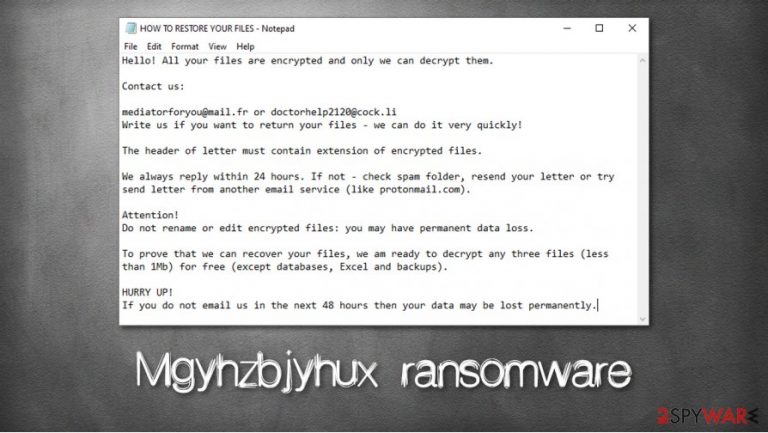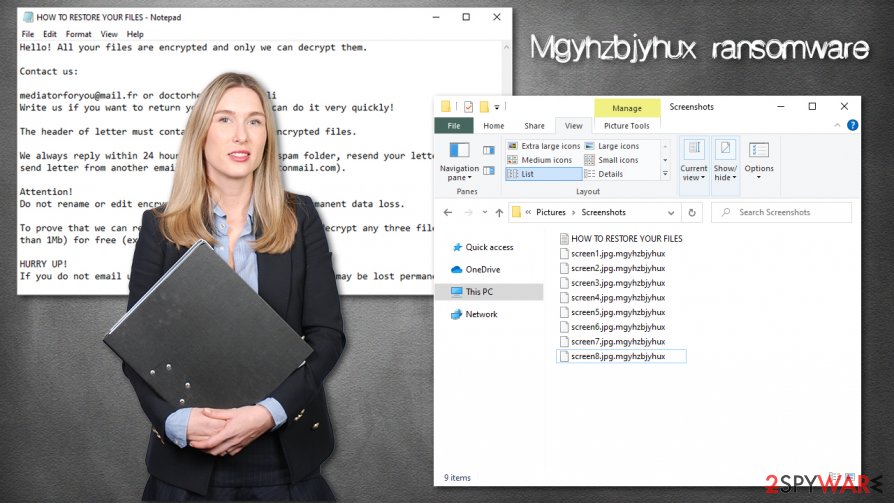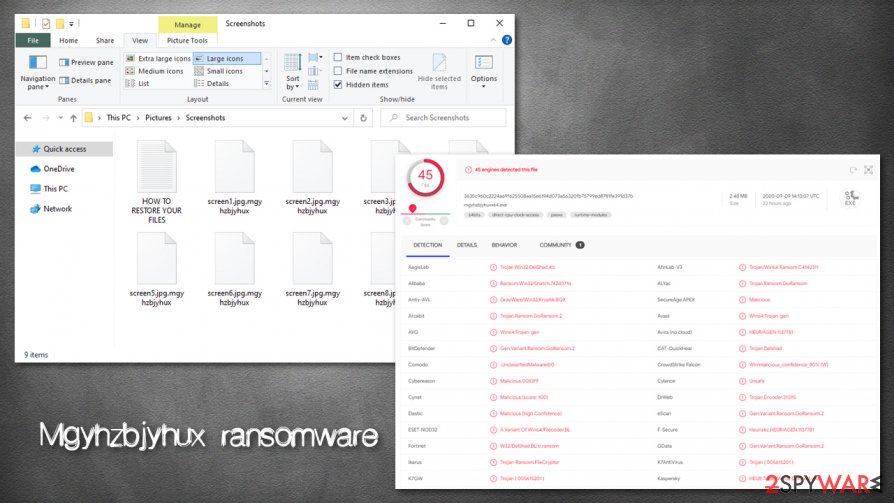Mgyhzbjyhux ransomware (Virus Removal Instructions) - Free Guide
Mgyhzbjyhux virus Removal Guide
What is Mgyhzbjyhux ransomware?
Mgyhzbjyhux ransomware – crypto-malware that threatens to publish personal data if ransom is not paid

Mgyhzbjyhux ransomware is a new variant of an extensive malware family known as Snatch, which typically targets corporate networks and businesses via unprotected Remote Desktop connections exposed to the internet. Once inside, the malware performs file encryption with the help of the AES[1] algorithm and appends .mgyhzbjyhux extension to pictures, music, videos, documents, databases, and other data located on local and networked drives.
To redeem access to personal files, victims require a unique key that is only accessible to malicious actors behind the Mgyhzbjyhux ransomware. As evident, they do not want to provide it for free and use it as an extortion mechanism in order to make users pay bitcoins. Hackers leave a ransom note HOW TO RESTORE YOUR FILES.TXT behind, which explains what happened and asks users to send an email at mediatorforyou@mail.fr or doctorhelp2120@cock.li with the particular extension.
| Name | Mgyhzbjyhux ransomware |
| Type | File locking virus, crypto-malware |
| Family | Snatch ransomware, which is known to target corporations and businesses, and ask for high sums for a decryption tool, as well as a guarantee of confidentiality (attackers steal sensitive corporate data and threaten to publish it if a ransom is not paid) |
| Distribution | Brute-force attacks performed via RDP connection that are publicly accessible via the internet |
| Encryption method | AES |
| File extension | All predetermined file types are encrypted, and a .mgyhzbjyhux extension added. For example, a “picture.jpg” is transformed into “picture.jpg.mgyhzbjyhux,” can can no longer be accessed |
| Ransom note | HOW TO RESTORE YOUR FILES.TXT is dropped on the desktop and other places on the computer where encrypted files are located |
| Contact | mediatorforyou@mail.fr or doctorhelp2120@cock.li |
| Data recovery | The only secure way to restore files is by using data backups. If such are not available or were encrypted as well, options for recovery are very limited – we provide all possible solutions below |
| Malware removal | Each of the infected computers should be first disconnected from a network, and then a thorough scan with anti-malware, such as SpyHunter 5Combo Cleaner or Malwarebytes, should be performed. In case malware disables security software, Safe Mode with Networking should be accessed as per the instructions below |
| System fix | Malware can often damage several Windows components and result in OS corruption. To repair such damage done by the virus, we recommend using a repair program, such as FortectIntego |
Snatch ransomware family is among the largest ones that specialize in the “big game hunting” tactic; others include Maze, DoppelPaymer, or Clop. Threat actors behind the Mgyhzbjyhux file virus are known to be using brute-force tactics after scanning the internet for vulnerable Remote Desktop connections. Thus, while the targets are picked based on availability, attacks are most commonly performed against companies rather than individuals.
As soon as the attackers break into the system, they move laterally by using the domain controller until they acquire an administrative account. During this time, they do not deploy Mgyhzbjyhux ransomware for file locking process, but rather snoop around and look for data to be extracted. These files typically consist of secret corporate documents that should not be accessed by the public.
Finally, Mgyhzbjyhux ransomware is installed on the network via human actions, security software disabled, and backups removed (if the attackers managed to access them). As for the general functionality of the virus, it also deletes Shadow Volume Copies, modifies the Windows registry, and performs other changes for the file encryption process to be successful. These changes might also disrupt the normal operation of Windows, even after Mgyhzbjyhux ransomware removal is performed (to remediate the OS, we recommend using FortectIntego repair software).
During the file encryption process, malware might reboot the system into Safe Mode so that security software would fail to stop the intrusion and data compromise. The most commonly targeted file types include PDF, MS Office documents, and other relevant items.

As soon as the encryption is finished, victims can find a ransom note HOW TO RESTORE YOUR FILES.TXT, which is dropped on various places on the infected system. The note claims the following:
Hello! All your files are encrypted and only we can decrypt them.
Contact us:mediatorforyou@mail.fr or doctorhelp2120@cock.li
Write us if you want to return your files – we can do it very quickly!The header of letter must contain extension of encrypted files.
We always reply within 24 hours. If not – check spam folder, resend your letter or try send letter from another email service (like protonmail.com).
Attention!
Do not rename or edit encrypted files: you may have permanent data loss.To prove that we can recover your files, we am ready to decrypt any three files (less than 1Mb) for free (except databases, Excel and backups).
HURRY UP!
If you do not email us in the next 48 hours then your data may be lost permanently.
As evident, malicious actors are using various hints that are meant to make victims decide to pay the ransom. For example, they claim that the decryption service is guaranteed and that they offer a free test decryption service as a means of proof that the .mgyhzbjyhux file decryptor is functional. On the other hand, they also claim that users only have 48 hours to decide before the required AES key is depleted from their servers – a sense of urgency is created in such a way.
However, paying criminals is quite risky, as some victims might never retrieve the required key. As a result, they might not only lose access to their files but also money that they pay to criminals.
Instead, security researchers[2] advise to restore data from backups and remove Mgyhzbjyhux ransomware from the infected computers and networks. For the purpose, a powerful anti-malware should be used – we recommend SpyHunter 5Combo Cleaner or Malwarebytes, although other powerful solutions should work as well.
Dangers of ransomware: businesses and companies are forced to pay ransom due to additional extortion techniques
There are several ways of how to restore .mgyhzbjyhux files without paying ransom – backups, recovery software, free decryption tools available from security experts, etc. The attackers, however, want to ensure that the ransom is paid, regardless of accessibility to alternative decryption methods.
Mgyhzbjyhux ransomware developers attack corporations to obtain the maximum amount of profit, although they spend more time when engaging in these attacks. Unlike malware strains such as Kasp or Geno, corporate-focused infections are more targeted but also count on larger ransom sums for the decryption solution.

Most companies, however, retain backups on a regular basis as the security procedure, rendering malware infection much less effective. To increase the possibility of the payment, crooks are now employing a different technique – they harvest sensitive information after the break-in, and then threaten to expose it online if the ransom demands are not met in time. For this reason, many companies are forced to pay ransoms despite having access to locked files.[3]
The correct way to remove Mgyhzbjyhux files virus
Typically, anti-malware software can detect and stop the intrusion of malware. However, since the Mgyhzbjyhux virus is installed manually by attackers, such defenses might get disabled. Otherwise, the payload of this variant is recognized by various security programs as follows:[4]
- Gen:Variant.Ransom.GoRansom.2
- Ransom:Win64/Snatch.A!MTB
- W32/DelShad.BL!tr.ransom
- A Variant Of Win64/Filecoder.BL
- Trojan.Win32.DelShad.4!c, etc.
In case no backups were retained, it is important to make a copy of the encrypted data before Mgyhzbjyhux ransomware removal is performed. Only then a full system scan should be initiated after each of the affected computers is disconnected from the network.
After you remove Mgyhzbjyhux ransomware, you can restore all data from backups or refer to the section below for alternative methods. Unfortunately, cybercriminals might not hesitate to publish the stolen information during intrusion if they do not receive the payment.
Getting rid of Mgyhzbjyhux virus. Follow these steps
Manual removal using Safe Mode
You can perform a full system scan in Safe Mode in case ransomware is tampering with your security software:
Important! →
Manual removal guide might be too complicated for regular computer users. It requires advanced IT knowledge to be performed correctly (if vital system files are removed or damaged, it might result in full Windows compromise), and it also might take hours to complete. Therefore, we highly advise using the automatic method provided above instead.
Step 1. Access Safe Mode with Networking
Manual malware removal should be best performed in the Safe Mode environment.
Windows 7 / Vista / XP
- Click Start > Shutdown > Restart > OK.
- When your computer becomes active, start pressing F8 button (if that does not work, try F2, F12, Del, etc. – it all depends on your motherboard model) multiple times until you see the Advanced Boot Options window.
- Select Safe Mode with Networking from the list.

Windows 10 / Windows 8
- Right-click on Start button and select Settings.

- Scroll down to pick Update & Security.

- On the left side of the window, pick Recovery.
- Now scroll down to find Advanced Startup section.
- Click Restart now.

- Select Troubleshoot.

- Go to Advanced options.

- Select Startup Settings.

- Press Restart.
- Now press 5 or click 5) Enable Safe Mode with Networking.

Step 2. Shut down suspicious processes
Windows Task Manager is a useful tool that shows all the processes running in the background. If malware is running a process, you need to shut it down:
- Press Ctrl + Shift + Esc on your keyboard to open Windows Task Manager.
- Click on More details.

- Scroll down to Background processes section, and look for anything suspicious.
- Right-click and select Open file location.

- Go back to the process, right-click and pick End Task.

- Delete the contents of the malicious folder.
Step 3. Check program Startup
- Press Ctrl + Shift + Esc on your keyboard to open Windows Task Manager.
- Go to Startup tab.
- Right-click on the suspicious program and pick Disable.

Step 4. Delete virus files
Malware-related files can be found in various places within your computer. Here are instructions that could help you find them:
- Type in Disk Cleanup in Windows search and press Enter.

- Select the drive you want to clean (C: is your main drive by default and is likely to be the one that has malicious files in).
- Scroll through the Files to delete list and select the following:
Temporary Internet Files
Downloads
Recycle Bin
Temporary files - Pick Clean up system files.

- You can also look for other malicious files hidden in the following folders (type these entries in Windows Search and press Enter):
%AppData%
%LocalAppData%
%ProgramData%
%WinDir%
After you are finished, reboot the PC in normal mode.
Remove Mgyhzbjyhux using System Restore
System Restore can also be used for malware elimination:
-
Step 1: Reboot your computer to Safe Mode with Command Prompt
Windows 7 / Vista / XP- Click Start → Shutdown → Restart → OK.
- When your computer becomes active, start pressing F8 multiple times until you see the Advanced Boot Options window.
-
Select Command Prompt from the list

Windows 10 / Windows 8- Press the Power button at the Windows login screen. Now press and hold Shift, which is on your keyboard, and click Restart..
- Now select Troubleshoot → Advanced options → Startup Settings and finally press Restart.
-
Once your computer becomes active, select Enable Safe Mode with Command Prompt in Startup Settings window.

-
Step 2: Restore your system files and settings
-
Once the Command Prompt window shows up, enter cd restore and click Enter.

-
Now type rstrui.exe and press Enter again..

-
When a new window shows up, click Next and select your restore point that is prior the infiltration of Mgyhzbjyhux. After doing that, click Next.


-
Now click Yes to start system restore.

-
Once the Command Prompt window shows up, enter cd restore and click Enter.
Bonus: Recover your data
Guide which is presented above is supposed to help you remove Mgyhzbjyhux from your computer. To recover your encrypted files, we recommend using a detailed guide prepared by 2-spyware.com security experts.If your files are encrypted by Mgyhzbjyhux, you can use several methods to restore them:
Data Recovery Pro method might be useful
Data Recovery Pro might be able to find some working copies of .Mgyhzbjyhux files from within the hard drive.
- Download Data Recovery Pro;
- Follow the steps of Data Recovery Setup and install the program on your computer;
- Launch it and scan your computer for files encrypted by Mgyhzbjyhux ransomware;
- Restore them.
Windows Previous Versions feature can be used to recover files one-by-one
In case malware failed to remove Shadow Copies, this method can be used to recover items individually.
- Find an encrypted file you need to restore and right-click on it;
- Select “Properties” and go to “Previous versions” tab;
- Here, check each of available copies of the file in “Folder versions”. You should select the version you want to recover and click “Restore”.
ShadowExplorer solution
ShadowExplorer can help automate the file recovery if Shadow Volumes are still intact.
- Download Shadow Explorer (http://shadowexplorer.com/);
- Follow a Shadow Explorer Setup Wizard and install this application on your computer;
- Launch the program and go through the drop down menu on the top left corner to select the disk of your encrypted data. Check what folders are there;
- Right-click on the folder you want to restore and select “Export”. You can also select where you want it to be stored.
No decryption solution is currently available
Finally, you should always think about the protection of crypto-ransomwares. In order to protect your computer from Mgyhzbjyhux and other ransomwares, use a reputable anti-spyware, such as FortectIntego, SpyHunter 5Combo Cleaner or Malwarebytes
How to prevent from getting ransomware
Protect your privacy – employ a VPN
There are several ways how to make your online time more private – you can access an incognito tab. However, there is no secret that even in this mode, you are tracked for advertising purposes. There is a way to add an extra layer of protection and create a completely anonymous web browsing practice with the help of Private Internet Access VPN. This software reroutes traffic through different servers, thus leaving your IP address and geolocation in disguise. Besides, it is based on a strict no-log policy, meaning that no data will be recorded, leaked, and available for both first and third parties. The combination of a secure web browser and Private Internet Access VPN will let you browse the Internet without a feeling of being spied or targeted by criminals.
No backups? No problem. Use a data recovery tool
If you wonder how data loss can occur, you should not look any further for answers – human errors, malware attacks, hardware failures, power cuts, natural disasters, or even simple negligence. In some cases, lost files are extremely important, and many straight out panic when such an unfortunate course of events happen. Due to this, you should always ensure that you prepare proper data backups on a regular basis.
If you were caught by surprise and did not have any backups to restore your files from, not everything is lost. Data Recovery Pro is one of the leading file recovery solutions you can find on the market – it is likely to restore even lost emails or data located on an external device.
- ^ Advanced Encryption Standard. Wikipedia. The free encyclopedia.
- ^ Udenvirus. Udenvirus. Security research and malware insights.
- ^ Jack Stubbs. 'Payment sent' - travel giant CWT pays $4.5 million ransom to cyber criminals. Reuters. Breaking news in markets, business, politics, entertainment, technology, video.
- ^ mgyhzbjyhuxx64.exe. Virus Total. File and URL analysis.







